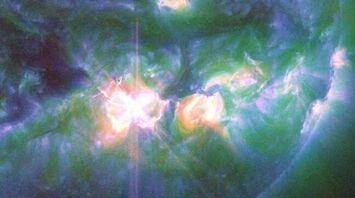Biggest solar flare since 2017 erupts from sun and Earth is in the firing line

The sun has once again demonstrated its immense power by unleashing its most intense solar flare since 2017, marking the 42nd X-class flare this year. Occurring after a similarly intense eruption earlier the same week, these solar events have generated coronal mass ejections (CMEs) that are anticipated to hit Earth, potentially causing vivid aurora displays over large areas. The latest formidable flare, erupting from sunspot AR3842 on October 3rd with a magnitude of at least X9, surpasses the previous record-holder of this solar cycle, which occurred in May.
Notably, this is the most potent solar eruption since the significant X11.8 and X13.3 flares in late 2017. The recent flare has already caused radiation to bypass Earth's magnetosphere, ionizing the upper layers of the atmosphere and causing radio blackouts over regions in Africa and the South Atlantic. Researchers have projected that this CME is likely to collide with Earth around October 6th.

Earlier on October 1st, the identical sunspot produced an intense X7.1 flare, the third most powerful in the current cycle, affecting communications over the Pacific Ocean. A geomagnetic storm – capable of penetrating deep into the atmosphere and sparking auroras – is predicted by the National Space Weather Prediction Center, which forecasts a storm between October 4th and 6th with a "strong" G3 level intensity.
These huge solar flares indicate that the sun has reached the explosive maximum of its approximately 11-year solar cycle, occurring sooner and more actively than initially predicted, prompting revisions in scientific projections. Highlights of solar activity this year include the most intense geomagnetic storm in 21 years in May, linked with the sunspots reaching a peak in visibility last seen 23 years ago.
In conclusion, heightened auroral activity is expected in the coming months due to better alignment of Earth's magnetic field with solar winds near the fall equinox, making magnetosphere impacts more likely. Researchers caution about more potential flares from sunspot AR3842 in the near future, keeping Earth's watch on the sun ever vigilant.
Earlier, SSP wrote about viking age burials in Denmark.



















